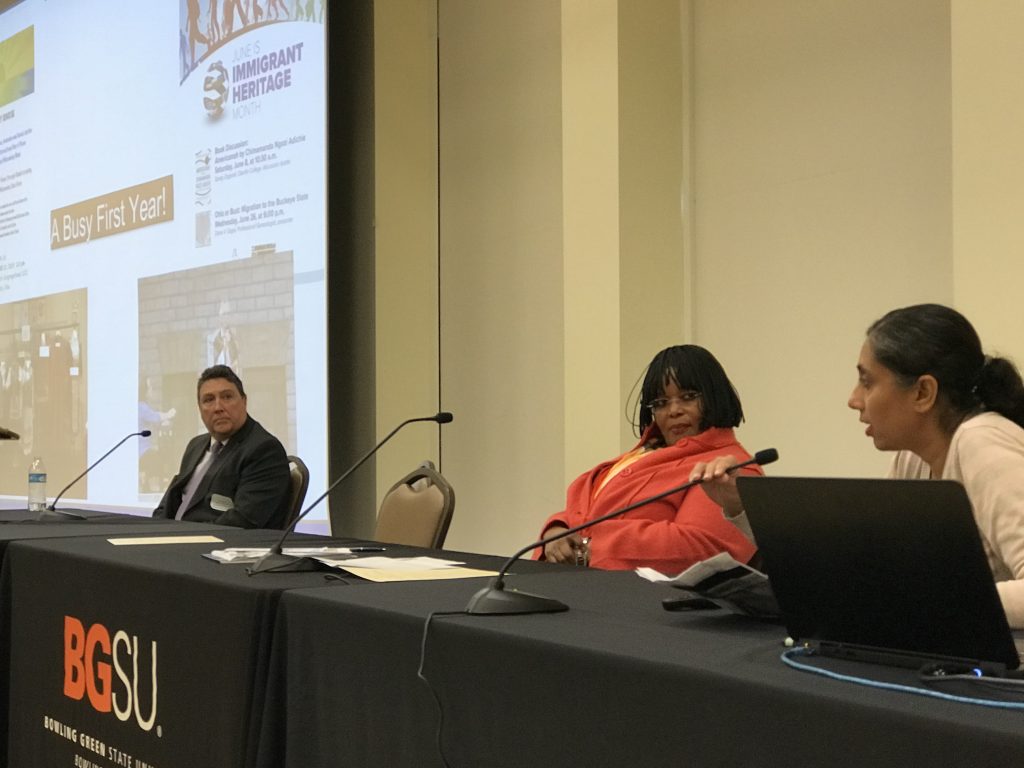By DAVID DUPONT
BG Independent News
Those advocating for welcoming immigrants and refugees to this country have a lot of numbers to back up their claims.
Kamala Mojabeng, of Welcome BG, said the local initiative was driven by a need for workers. The streets are lined with signs announcing “hiring now.”
The need is in hospitality, service, and, especially, in the growing manufacturing sector, she said.
She was one of those speaking at Thursday’s Immigrant, Ohio’s Ohio’s Welcoming Initiatives for Immigrants conference at Bowling Green State University.

Mojabeng has been working with employers to help them figure out the intricacies of visas and translating credentials from foreign countries.
She related a case where that didn’t happen. A Kenyan student who was completing an engineering doctorate could not find work at local firms because they were uncertain about his credentials. Mojabeng told her husband, who told her the company in Findlay he worked for needed people. So the student found a $64,000 a year job in Findlay.
That’s Bowling Green’s loss, she said.
It’s no coincidence that her recently opened office is right outside the door of the Bowing Green Economic Development office. The director of that office, Suzanne Clark, was a leading proponent of the city passing a welcoming resolution.
Clark chaired a panel on just that topic Immigrant’s and Ohio Economy.
The city is losing money because employers can’t find enough workers to expand their businesses, she said. Immigrants can provide a solution.
But the national climate is not always friendly to these newcomers.
Earlier in the day, Soni Vyas said the change in the national environment for immigrants led her to spearhead the drive for a welcoming resolution in Sandusky.
Her parents, she said, now carry copies of their passports with them after her father was harassed about his citizen status at theDepartment of Motor Vehicles office.
He is a citizen and all he needs to renew his driver’s license is his driver’s license.
Then in summer, more than 100 people who were in this country without proper papers were rounded up at the local Corso’s gardening center by the Immigration and Customs Enforcement officers.
“That was absolutely devastating to the immigrant community out there,” Vyas said.
As a tourist town, Sandusky relies on seasonal foreign workers from the Philippines, Turkey, and China. So welcoming outsiders is essential.
D.J. Pryor, of the state office of Opportunities for New Americans, said immigrants make up 5 percent of the state’s population. They pay $4.49 billion in taxes.
They tend to be younger and hold jobs at a greater rate than native born Americans, he said.
He was followed on the panel by Nadia Kasvin, who came to this country as a refugee from Ukraine.
Kasvin of U.S. Together in Columbus, quickly backed up Pryor’s numbers with some of her own from Columbus and focusing on refugees, a particular class of immigrant. Refugees must have a documented fear of persecution because of their race, religion, nationality, or being a member of an oppressed group.
Refugees own 873 businesses that employ almost 4,000 people, both fellow refugees and native-born Americans. Refugees start businesses at twice the rate as native-born American.
In 20 years they’ve had an economic impact of $1.6 billion in Columbus.
Saying she’d “fulfilled her mission to talk about numbers,” she shifted gears.
Kasvin said that in the 26 years since she’s been here, the story told about refugees and why they should be welcomed has shifted.
At first, she said, the story was about the struggles refugees experienced, the persecution, “the reason we had to flee, why we had to find safety in another country.”
Then it shifted to a story of being a humanitarian effort.
“That was not enough,” Kasvin said. The emphasis shifted on the hardships refugees experienced living in open camps where they could not find work, go to school, or even seek medical treatment.
And when resistance persisted “we started talking about the process” and all the security protocols and bureaucratic hoops refugees had to jump through.
About eight years ago, Kasvin said, advocates started making the business case.
Back then the United States accepted about 95,000 refugees a year. In the last year of the Obama Administration, 110,000 were resettled here. Those numbers have since plummeted. In the last fiscal year 30,000 were resettled, and in the current year,18,000 will be allowed in, and that’s only because the Department of Defense insisted on it. Otherwise, she said, the United States would have allowed in zero.
“We need to tell our whole story,” she said. “The prosecution, the journey, settling, integrating and succeeding here.”
That the co-founder of Google was a refugee is not enough. That Einstein was a refugee is not enough.
“Do we welcome them because they open businesses or is it because it’s in the DNA of our country?”
If Americans looked deep enough they may find refugees in their families, though they might have been called that.
“How many stories do we need to tell so we continue to welcome refugees, people who escape horrors and yet are so resilient,” she said. “What do we need to do in all our communities to influence decision makers so next year we settle more than zero refugees?”

